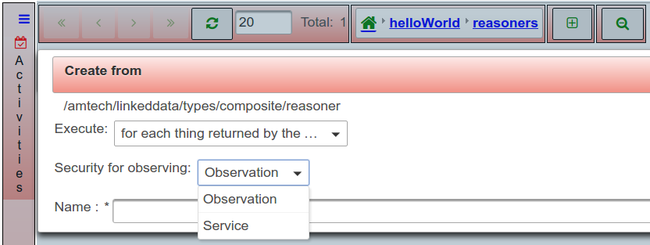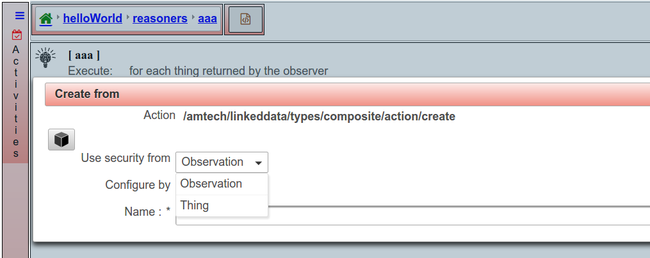Difference between revisions of "Execution engine"
(→Security context) |
(→Security context) |
||
| Line 36: | Line 36: | ||
[[File:action_security.png|650px|thumbnail|center|Security for objects being created]] | [[File:action_security.png|650px|thumbnail|center|Security for objects being created]] | ||
| − | Check [[Access_control#Access_while_executing_observers_in_the_reasoner.27s_engine|this section]] | + | Check [[Access_control#Access_while_executing_observers_in_the_reasoner.27s_engine|this section]] for further details. |
== Extension module == | == Extension module == | ||
Revision as of 13:54, 12 July 2018
Contents
CEP (Complex Event Processing — now called Event Stream Processing)
AMTech execution engine is an implementation of a CEP; it encapsulates CEP's complexity in the DAP design.
Execution feedback and/or errors
When an activity is being executed by the execution engine an observationlifecycle type is sent to the activity_lifecycle topic. Some events are reported through the property event, among this events:
- Start of a reasoner (BEGIN)
- End of a reasoner (END)
- Execution errors (ERROR)
The following example illustrates activity "producer": "thingsInBoardroom" reporting action "resourceuri": "/amtech/activities/thingsInBoardroom/reasoners/createThingInBoardroomFromEddystoneBeacon/actions/ReportThingInBoardroom" started "event": "BEGIN"
{
"topic": "/activity_lifecycle/thingsInBoardroom",
"guesttenants": [
"_ALL"
],
"event": "BEGIN",
"@type": "/amtech/linkeddata/types/composite/observation/observationlifecycle",
"producer": "thingsInBoardroom",
"resourceuri": "/amtech/activities/thingsInBoardroom/reasoners/createThingInBoardroomFromEddystoneBeacon/actions/ReportThingInBoardroom",
"detectiontime": "Tue Apr 26 21:41:09 UTC 2016",
"@id": "/amtech/things/observations/983c488f-c3d4-44ec-85f2-795428d12d83",
"occurrencetime": "Tue Apr 26 21:41:08 UTC 2016"
}
- This is a strong mechanism you can use to trace the execution of your activities if, at a given moment, you think they are not working as expected.
Security context
When creating a reasoner, the user can select if the security info for executing the observer and running the reasoner's actions should be taken from the observation triggering the reasoner, or from the service to which the reasoner belongs.
- If using the observation security
- The observer will return only those things readable by the tenant of the observation. Also, all actions that create objects (things, observations, notifications, etc) will initialize the security context of the object being created with the security context of the observation being consumed.
- The actions will be executed using the tenant of the observation
- If using the service security
- The observer will return all the things readable by the service. Also, all actions that create objects (things, observations, notifications, etc) will ask you to select between the security context of the observation being consumed and the security context of the thing being visited as the security context of the object being created.
- The actions will be executed using the service (representing all tenants subscribed to the service)
Check this section for further details.
Extension module
EPC
Electronic product code Tag Data Translation implemented according to the GS1 EPC Tag Data Translation 1.6 specification (http://www.gs1.org/epc/tag-data-translation-standard) Exposed as 2 JavaScript functions available for reasoner's JavaScript binding:
* epcEncode * epcDecode
They support the following codings:
- SGTIN-96, SGTIN-198, SSCC-96, SGLN-96, SGLN-195, GRAI-96, GRAI-170, GSRN-96, GSRNP-96, GDTI-96, GDTI-174, GID-96.
Debug
Geospatial libraries
A couple of libraries are available in JavaScript bindings:
You can make use of these libraries using the variables geolib and terraformer that are initialized as follows:
var geolib = require('geolib');
var terraformer = require('terraformer');
Example binding location property to a new created geofence thing, using the location from observation and calculating a circle with 300 radius
function(observation)
{
var location;
//get wkt json
var loc = JSON.parse(observation.location);
//parse longitude and latitude from wkt text
var point = terraformer.WKT.parse(loc.wkt);
//create a circle with 100 metres radius
var circle = new terraformer.Circle([point.coordinates[0], point.coordinates[1]], 100, 64);
//create location wkt
location = terraformer.WKT.convert(circle.geometry);
//wkt poligon location bind to created geofence thing
return location;
}

